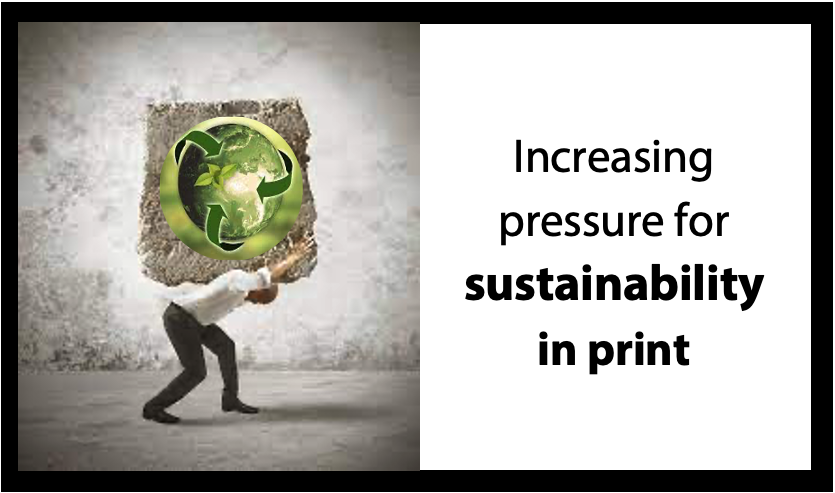This is the first article in our series to explore sustainability and its impact on inkjet printing and innovation. The pressure is mounting for companies to offer sustainable products and for companies themselves to be sustainable. This article looks at drivers for sustainability and what it means for the future of inkjet.
Sustainable Development Goals (SDGs), corporate sustainability officers, annual sustainability reports, net carbon zero targets, lower energy requirements to complete a given process, bio-based raw materials, an increase in recycling… The list goes on increasing pressure for companies to offer more sustainable products and for they themselves to also be sustainable. Saying a product or company is sustainable is no longer enough. Organizations must prove they and their products are sustainable. Sustainability is not a new concept for the printing industry. So why has the pressure increased to take action?
What is Sustainability?
There is not one universally accepted definition of sustainability. Merriam-Webster simply defines sustainability as capable of being sustained. As such, leaders in print industry innovation from equipment manufacturers to inks and coatings suppliers commonly reference the Sustainable Development Goals from the United Nations to frame their own sustainability commitments.
In 2015, the United Nations Member States adopted the 2030 Agenda for Sustainable Development calling for global cooperation to meet 17 Sustainable Development Goals.

- No Poverty
- Zero Hunger
- Good Health and Well-Being
- Quality Education
- Gender Equality
- Clean Water and Sanitation
- Affordable and Clean Energy
- Decent Work and Economic Growth
- Industry, Innovation and Infrastructure
- Reduced Inequalities
- Sustainable Cities and Communities
- Responsible Consumption and Production
- Climate Action
- Life Below Water
- Life On Land
- Peace, Justice and Strong Institutions
- Partnerships For The Goals
The SDGs have expanded sustainability from climate action to a holistic ideal of sustaining human life. More specific action and metrics around the SDGs is likely as the United Nations prepares for its next conference on climate change in November 2021. Today, which goals an organization supports and the metrics used to denote progress are determined by the organization.
Drivers
Supply chains flow two ways. Products move from raw materials to inks and coatings suppliers to equipment suppliers to printers, brands and ultimately consumers. Drivers and trends for sustainability are coming the opposite direction with consumers demanding sustainable products and sustainable companies with whom they prefer to do business.

Consumer Demand
According to Forbes, Millennials (people born between 1981 and 1996) exhibit eight characteristics that make them likely to invest and work in companies that have embraced visible sustainable practices. Millennial spending power was estimated at $1.4 trillion in 2020, making them the largest consumer demographic.
Brand Demand
As economics are quantified into potential opportunities, consumer insistence translates into shareholder insistence which puts pressure on brands to take action. As an example, more than 200 brands are listed as members or partners to the Ellen MacArthur Foundation, an NGO focused on creating a circular economy, where as, many products as possible can be recycled and re-used rather than going to landfill. The NGO has committed to a 48% reduction of carbon dioxide emissions by 2030. The NGO estimates financial benefits for participation in the circular economy including $700 million annual material cost savings and $550 billion reduction in health care costs associated with the food sector.
Net Carbon Zero Emissions Targets
In another example, billionaire Bill Gates is calling for net carbon zero by 2050 in his latest book released in early 2021. Gates warns that left unchecked, carbon emissions will lead to climate damage so profound the world is likely to suffer Covid-sized economic effects every ten years. A growing number of organizations in the print industry have committed to reducing net carbon emissions and VOCs. These include the largest inks and coatings manufacturers: DIC, Flint, Siegwerk and digital print OEM HP, Epson, Canon and many others.

Opportunities for Digital Print
Digital print is known for its ability to quickly decorate products thereby enabling new business models where products can first be sold and then made. This new business model reduces inventories and waste, thereby positively impacting the SDG goals. More printers and brands are likely to adopt digital printing in their processes in order to achieve reduced waste.
The drive to lowering CO2 emissions should prove favorable to digital print. HP states that 65% lower CO2 emissions are possible from the digital print process based on a life cycle analysis report. As printers are expected to prove to brands how they are reducing carbon emissions, they will turn to digital print as a solution.
The quantified economic impact of sustainability backed by the spending power and buying behavior of Millenials will drive demand for sustainable products and sustainable companies. This will drive innovation in the print industry and digital print.
Digital print equipment OEMs will continue to announce reduced carbon emissions targets. HP has a goal of reducing greenhouse gas emissions by 30% by 2025 and has been named by Newsweek as “America’s Most Responsible Company” for the second straight year and continues its commitment to long term innovation. Epson has published a goal to become carbon negative by 2050 with commitments to the circular economy, open innovation and international environmental initiatives.
The world’s largest inks and coatings company, DIC and Sun Chemical announced a $100 million spend on innovation in 2020 that was largely for sustainable products.
In an effort to lower CO2 emissions, digital print will continue to innovate in inks, coatings, equipment energy use and curing mechanisms. The use of bio-based materials is one way of reducing CO2 emissions. Smithers states that bio-based materials innovation will occur in all areas of inks and coatings through 2026 driving a $2.7 billion increase in the bio-based inks and coatings market.
How is your organization taking advantage of digital print to deliver on sustainability goals? Share your story with us.

